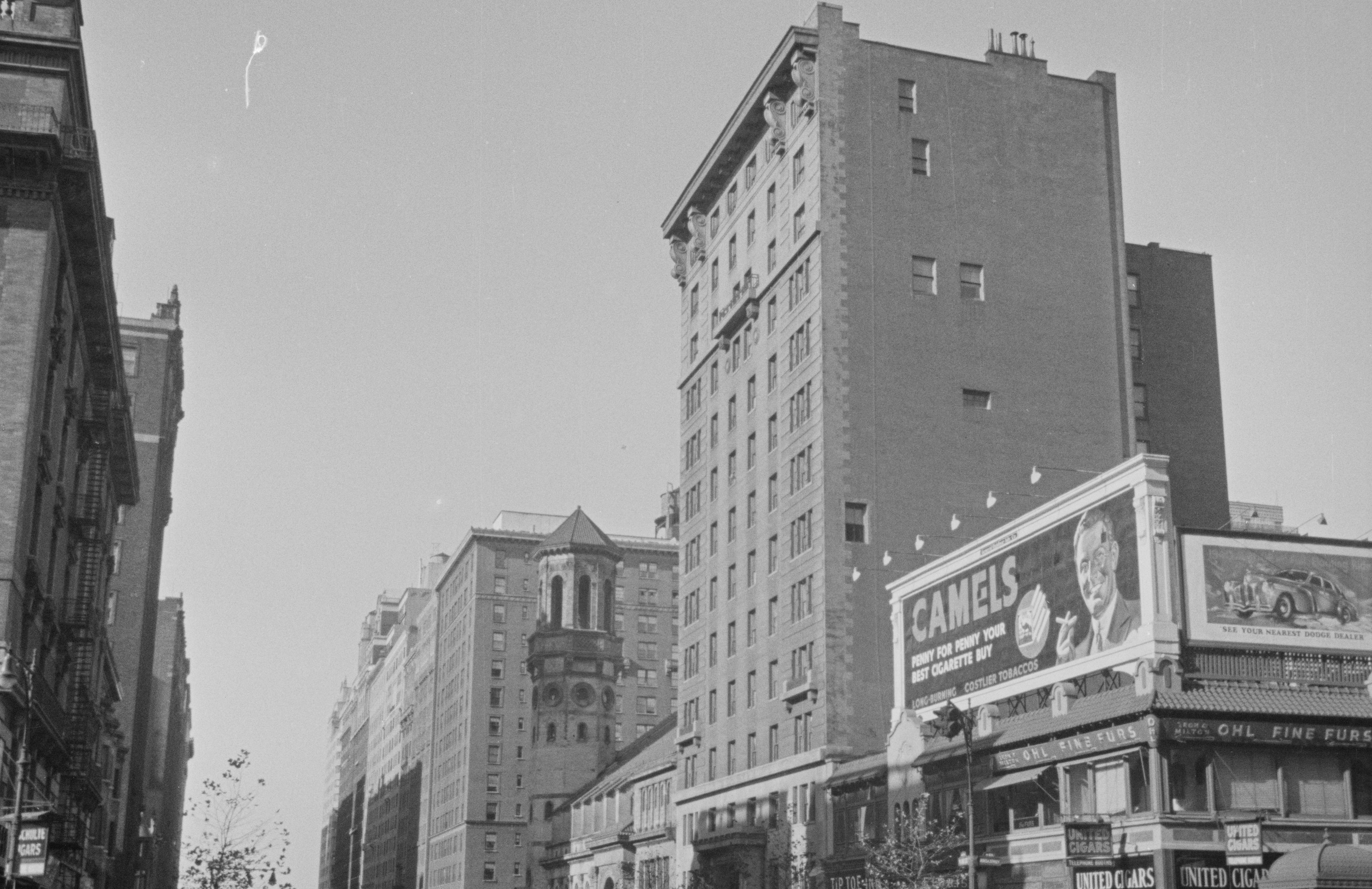
257 West 86th Street
by Tom Miller
In 1903 artist, V. V. Sewell mulled “people have no conception of how difficult it is for one to find a suitable studio in New York.” It was a problem that had prompted James Boorman Johnston to erect the famous 10th Street Studios Building in Greenwich Village nearly half a century earlier, in 1858. His was the first step in the movement of artist residence-workspace buildings that would gain momentum at the turn of the century.
Joining the trend in 1906 was the West 86th Street Studios Corp. It hired the architectural firm of Pollard & Steinam to design an upscale studio building at 255 through 259 West 86th Street, between West End Avenue and Broadway. Their plans, filed in May, called for a 12-story “brick and stone studio building” to cost $300,000–nearly $9 million in today’s money.
Completed in 1908, the neo-Italianate structure was, in fact, 14-stories tall. Its tripartite design featured a grand, double-height entrance with two-story piers upholding a substantial cornice. The limestone of the three-story base gave way to 11 stories of Roman brick, decorated with palazzo-inspired pseudo balconies. The building faced north, providing artists the much sought after natural northern light. Of the 41 apartments, many were duplexes, offering soaring double-height studio spaces. The larger suites had as many as eight rooms.
Among the initial residents were playwright and author Lee Wilson Dodd and his wife, the former Marion Roberts Canby. In 1909, soon after they moved in, Dodd’s play The Return of Eve was produced on Broadway. Around the same time he published a book of poems, A Modern Alchemist, of which he said, “The critics told the public it was good but the public did not happen to be listening.”
As intended, the building attracted artists and musicians. Portrait painter Ernest L. Ipsen was another early resident, as was pianist Paolo Martucci, the son of the Italian composer Giuseppe Martucci. On December 20, 1914 The New York Press noted, “Martucci, who recently has renewed his teaching in his new studio No. 257 West Eighty-sixth street, is conceded to be one of the foremost of modern piano virtuosi.”
Their plans, filed in May, called for a 12-story “brick and stone studio building” to cost $300,000–nearly $9 million in today’s money.
At the time of the article, Martucci intended to travel to Europe, but the worsening political tensions abroad ended those plans. On May 22, 1915, Musical America noted that he had “made a most successful appearance at the popular concert at the Metropolitan Opera House on February 7,” but “will be unable to take his usual trip to Europe. He will remain in New York City during the entire summer and will teach at his studios, No. 257 West Eighty-Sixth Street.”
Other musicians in the building at the time were Arthur E. Stahlschmidt, who trained pupils in “all branches of voice production for the singing or speaking artist;” and soprano Charlotte Lund.
Not all residents was associated with the arts. The highly respected engineer Frederick Remsen Hutton and his family were among the building’s initial residents. He was the former dean of the faculty 0f engineering at Columbia University and had written several engineering textbooks. Sharing the apartment was their adult son, Dr. Lefferts Hutton. Following his marriage to Esther Whitney in 1915, he and his bride continued to live in the building.
That year there were two vacancies in the building. An advertisement on August 22 offered a duplex “of eight rooms and two baths.” The studio section had 18-foot ceilings. The rent was not cheap–equal to about $6,000 per month today. The other apartment was a “single,” with “north light, of studio, bedroom, kitchenette and bath…including service.” The ad noted there was a “mail chute [and] house water filter.” The rent for that space was equivalent to about $2,200 per month today.
Novelist, screenwriter and motion picture producer Louis Joseph Vance and his wife, the former Anne Elizabeth Hodges, signed a lease in July 1916. He had founded Fiction Pictures, Inc. the previous year.
Exhibiting in the 1917 exhibition of The Society of Independent Artists at the Grand Central Palace on Lexington Avenue were residents Marian Y. Bloodgood, Oscar Fehrer, Franklin De Haven, and Charles L. Wachter.
Franklin De Haven would live and work from the West 86th Street Studios for years. He had married Elizabeth Woodcock in 1902. He was a member of the National Academy of Design, the Salmagundi Club, the National Arts Club and the Allied Artists of America.
The West 86th Street Studios was known as a “partial cooperative” building, meaning that some of the studios were owned by the residents. Composer and impresario David Gould Proctor was among the owners. He graduated from Columbia University in 1900 and then served with Scotland Yard in London during World War I. Back at home, he headed his own theatrical company and wrote piano compositions and songs.
In August 1922, Proctor sold his “large duplex studio apartment,” as described by the New York Herald, to Charles Otis. Otis was president of The Wall Street Journal and of Dow Jones & Company. He was, as well, publisher of American Banker and Bond Buyer.
Also living in the building that year were artist John R. Koopman, motion picture actor Ira M. Lowry, and pianist C. Virgil Gordon. Lowry, who had appeared in silent films like the 1918 For the Freedom of the East, and 1919 releases Speedy Meade, The Road Called Straight, and a Misfit Earl, found himself on the wrong side of the law in 1922.
On July 29 The Evening World reported, “Ira M. Lowry, thirty-three, a motion picture actor, living at No. 257 West 86th Street, was locked up last night in the West 47th Street Station on an indictment charging grand larceny.” A Fifth Avenue jeweler, Rudolph Hammell, accused Lowry of taking $9,500 worth of jewelry–more than $145,000 today–“on memorandum” and not returning it. The practice of allowing a potential customer to essentially borrow pieces for approval was common–as was theft.
On December 18, 1929 The New York Times reported, “Mr. and Mrs. Frederic Dixon and Mrs. J. C. b. Hebbard gave a musical last night at the studio of Mr. and Mrs. Dixon, 257 West Eighty-Sixth Street. Miss Leonora Corona of the Metropolitan Opera Company was the guest of honor. She and Mr. Dixon gave a piano program.” Frederic Dixon had studied piano under Fanny Bloomfield-Zeisler and Rafael Joseffy. Joseffy had commented at one point that he “regretted he was not destined to live long enough to see this pupil become famous.”
The piano on which Dixon played that night was a rarity, a Mason & Hamlin Ampico grand. According to the Chicago Tribune, at a time when a Steinway cost $1,000, a Mason & Hamlin Ampico grand sold for $25,000.
The practice of allowing a potential customer to essentially borrow pieces for approval was common–as was theft.
Another concert pianist, Conrad Forsberg, leased an apartment in the building in June 1931, at the height of the Great Depression. Despite the economic conditions, the West 86th Street Studios building did not suffer. On October 1, 1932 The New York Sun noted, “The building, semi-cooperative…was considered especially suited for artists and musicians. It not only proved popular with that clientele, but today is 100 per cent rented.”
Two of the building’s best known residents died in 1934. Franklin De Haven succumbed on January 10. His right foot had become infected at his summer home in Connecticut in 1933. It was amputated that November, but he died of complications on January 10, 1934. The 77-year-old had won scores of awards and his paintings today hang in prestigious museums nationwide.
Cartoonist and illustrator Dan Smith died of heart disease in his apartment on December 10 that year, surviving his wife, Wilhelmina, by about a year. Born in Greenland of Danish parents, he had studied art in New York, Philadelphia and Copenhagen, and became famous for his newspaper and magazine illustrations. The 69-year-old’s funeral was held in his apartment.
Another cartoonist living in the building was Rudolph Dirks, famous for his syndicated comic strip the “Katzenjammer Kids.”
The West 86th Street Studios continued to attract artists, musicians. In 1936 pianist, Harold Henry signed a lease. Sculptor Gutzon Borglum, who designed and sculpted Mount Rushmore, was a tenant; and in the early 1950’s voice coach William S. Brady had his studio here.
By 1965, Raoul Gelabert’s dance studio was in the building. Gelabert was a pioneer in kinesiotherapy for dancers. On September 10, 1979 New York Magazine noted, “A seasoned teacher and pioneer in the field of physical therapy for dancers, Raoul Gelabert runs children’s ballet classes at Gelabert Studios.” In 1989, he opened the Gelabert Studios Gallery, an art space, here.
More recently, actor Robert Duvall lived in the building.
There are still only 41 apartments in the building. The cornice, which was lost in the second half of the 20th century, was recently refabricated. Inside, much of Pollard & Steinam’s 1908 interior detailing survives.
Tom Miller is a social historian and blogger at daytoninmanhattan.blogspot.com


